Pecharsky V.K., Zavalij P.Y. Fundamentals of Powder Diffraction and Structural Characterization of Materials
Подождите немного. Документ загружается.

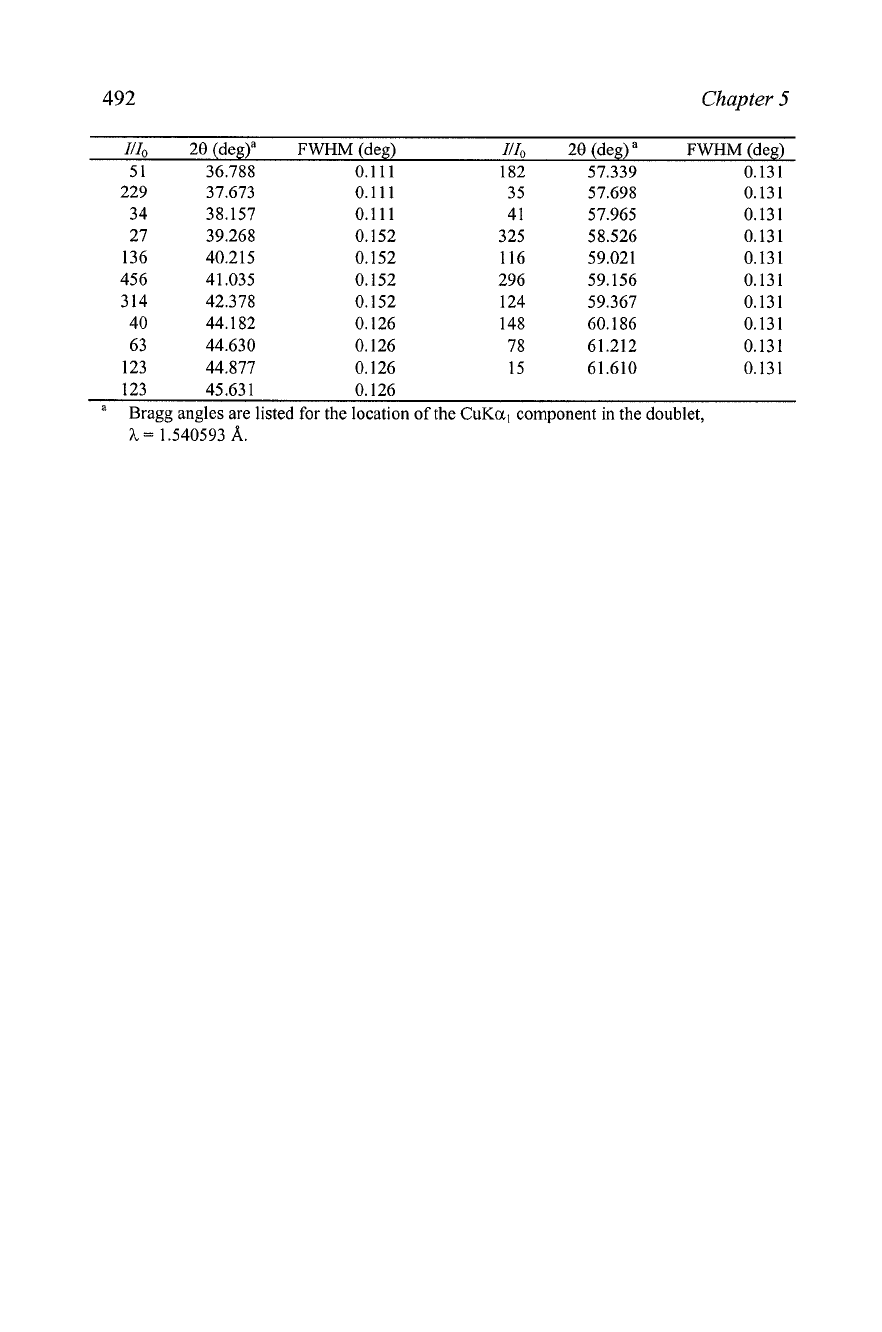
492
Chapter
5
111,
20
(deg)a
FWHM
(deg)
111,
20
(deg)
a
FWHM
(deg)
5 1 36.788 0.1 11 182 57.339 0.131
229 37.673 0.111 3 5 57.698
34 38.157 0.111 41 57.965
27 39.268 0.152 325 58.526
136 40.215 0.152 116 59.021
456 41.035 0.152 296 59.156
3 14 42.378 0.152 124 59.367
40 44.182 0.126 148 60.186
63 44.630 0.126 78 61.212
123 44.877 0.126 15 61.610
123 45.631 0.126
a
Bragg angles are listed for the location of the CuKa, component in the doublet,
h
=
1 .54O593
A.
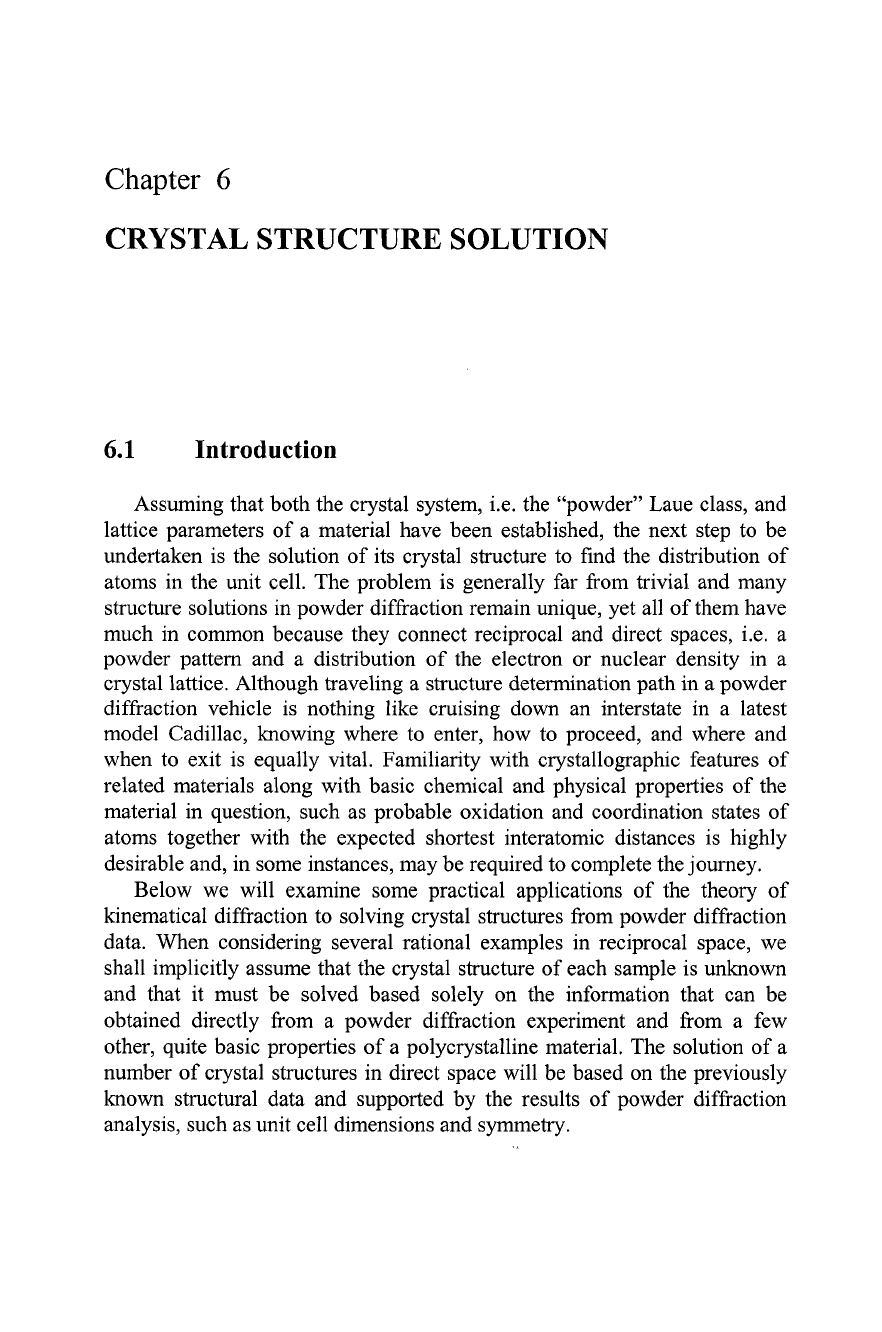
Chapter
6
CRYSTAL STRUCTURE SOLUTION
6.1
Introduction
Assuming that both the crystal system, i.e. the "powder" Laue class, and
lattice parameters of a material have been established, the next step to be
undertaken is the solution of its crystal structure to find the distribution of
atoms in the unit cell. The problem is generally far from trivial and many
structure solutions in powder diffraction remain unique, yet all of them have
much in common because they connect reciprocal and direct spaces,
i.e. a
powder pattern and a distribution of the electron or nuclear density in a
crystal lattice. Although traveling a structure determination path in a powder
diffraction vehicle is nothing like cruising down an interstate in a latest
model Cadillac, knowing where to enter, how to proceed, and where and
when to exit is equally vital. Familiarity with crystallographic features of
related materials along with basic chemical and physical properties of the
material in question, such as probable oxidation and coordination states of
atoms together with the expected shortest interatomic distances is highly
desirable and, in some instances, may be required to complete the journey.
Below we will examine some practical applications of the theory of
kinematical diffraction to solving crystal structures from powder diffraction
data. When considering several rational examples in reciprocal space, we
shall implicitly assume that the crystal structure of each sample is unknown
and that it must be solved based solely on the information that can be
obtained directly from a powder diffraction experiment and from a few
other, quite basic properties of a polycrystalline material. The solution of a
number of crystal structures in direct space will be based on the previously
known structural data and supported by the results of powder diffraction
analysis, such as unit cell dimensions and symmetry.
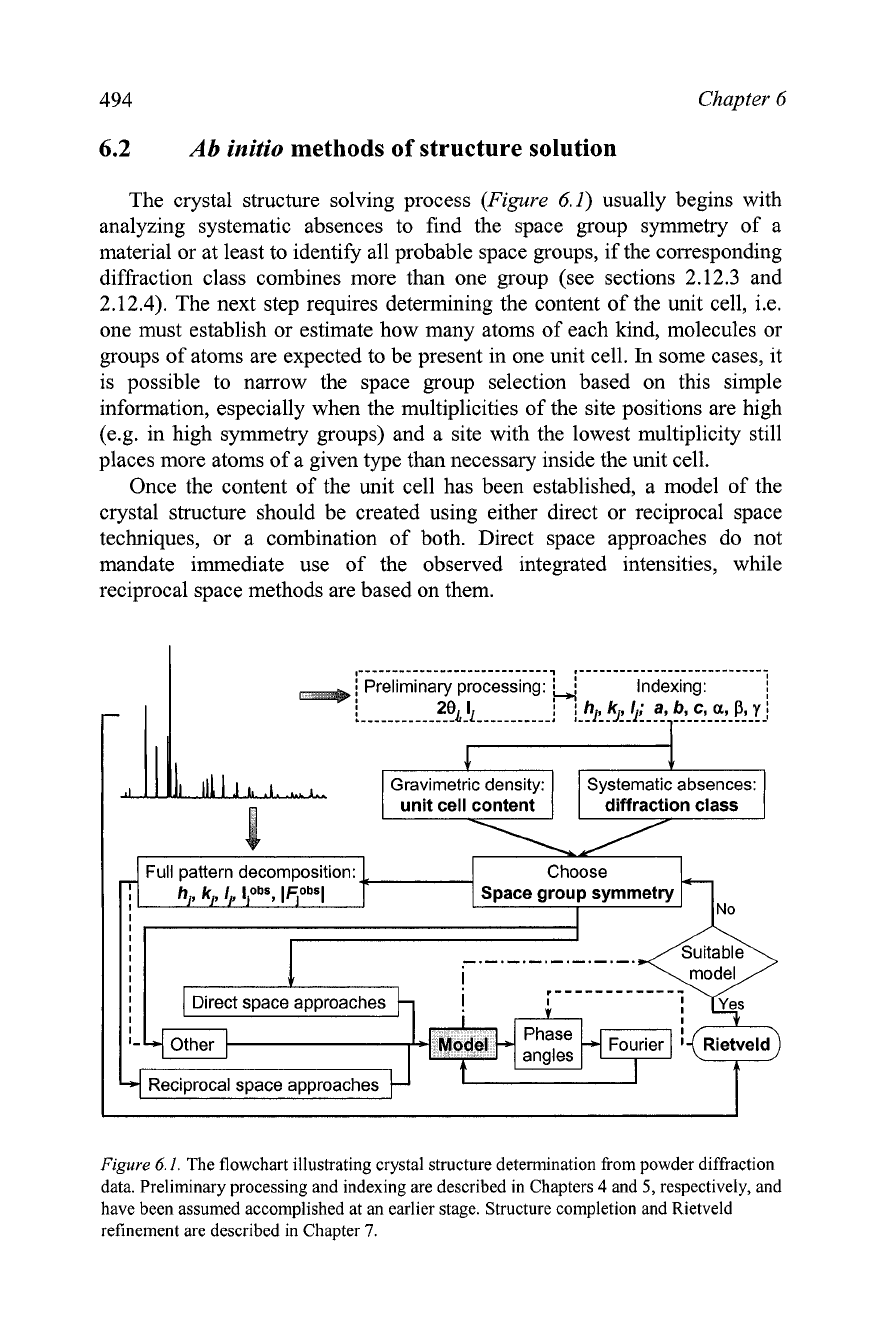
494
Chapter
6
6.2
Ab
initio
methods of structure solution
The crystal structure solving process (Figure
6.1)
usually begins with
analyzing systematic absences to find the space group symmetry of a
material or at least to identify all probable space groups, if the corresponding
diffraction class combines more than one group (see sections
2.12.3
and
2.12.4).
The next step requires determining the content of the unit cell, i.e.
one must establish or estimate how many atoms of each kind, molecules or
groups of atoms are expected to be present in one unit cell.
In
some cases, it
is possible to narrow the space group selection based on this simple
information, especially when the multiplicities of the site positions are high
(e.g. in high symmetry groups) and a site with the lowest multiplicity still
places more atoms of a given type than necessary inside the unit cell.
Once the content of the unit cell has been established, a model of the
crystal structure should be created using either direct or reciprocal space
techniques, or a combination of both. Direct space approaches do not
mandate immediate use of the observed integrated intensities, while
reciprocal space methods are based on them.
I
/
Preliminary processing:
$
Indexing:
28
1
,
~h
k
1.
a
b,c,a,Wyj
,--------------
i
--------------
L-r
..----------,
,--i:.j~-i:--?
Figure
6.
I.
The flowchart illustrating crystal structure determination from powder diffraction
data. Preliminary processing and indexing are described in Chapters
4
and
5,
respectively, and
have been assumed accomplished at an earlier stage. Structure completion and Rietveld
refinement are described in Chapter
7.
3.
I
Gravimetric density: Systematic absences:
unit cell content diffraction class
T)
Full pattern decomposition:
h,,
ki,
I],
ybs,
l50b~l
Choose
I
I
I
I
I
I
I
I
I
I
I
I
1
Direct space approaches
Reciprocal space approaches
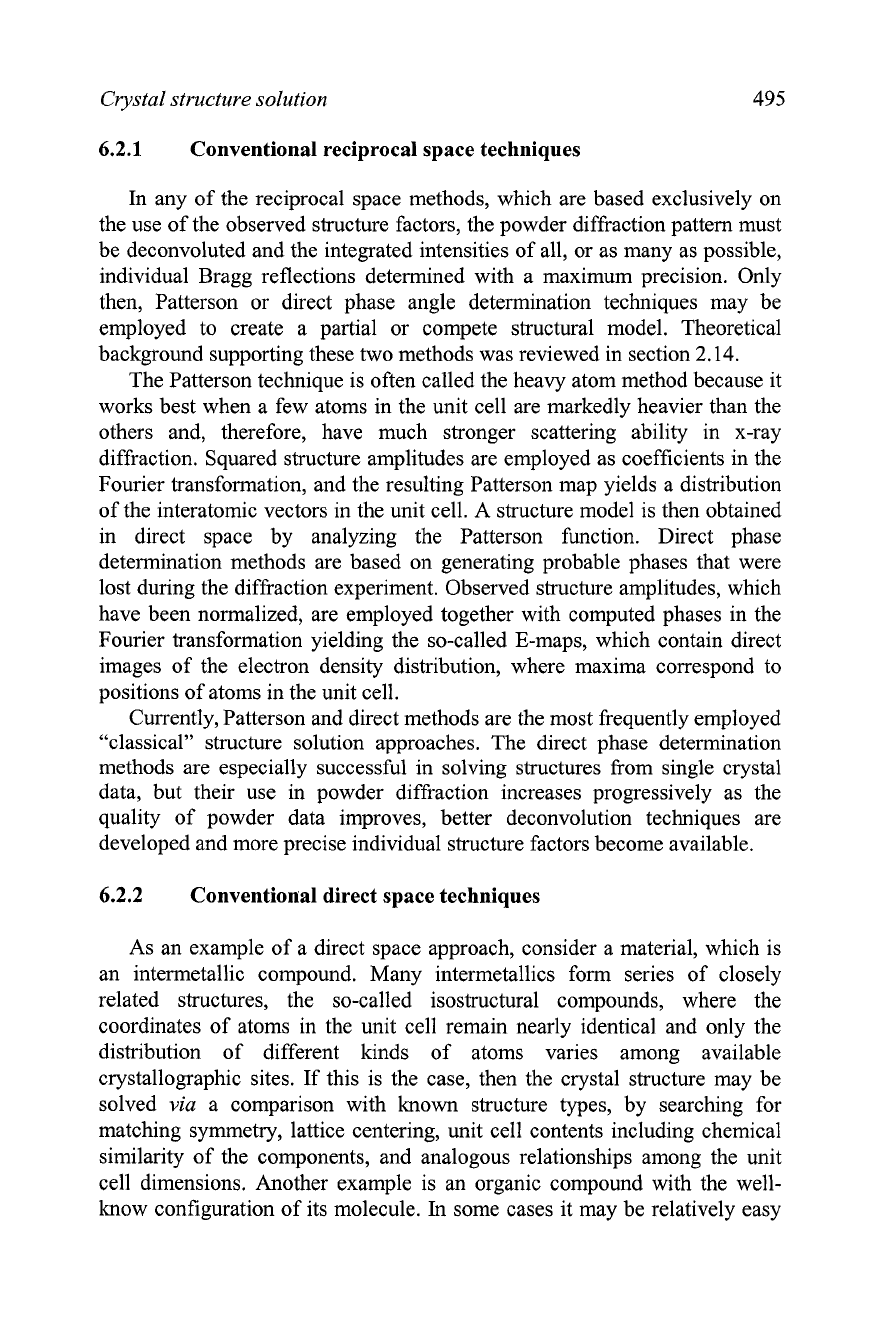
Crystal structure solution
495
6.2.1
Conventional reciprocal space techniques
In any of the reciprocal space methods, which are based exclusively on
the use of the observed structure factors, the powder diffraction pattern must
be deconvoluted and the integrated intensities of all, or as many as possible,
individual Bragg reflections determined with a maximum precision. Only
then, Patterson or direct phase angle determination techniques may be
employed to create a partial or compete structural model. Theoretical
background supporting these two methods was reviewed in section 2.14.
The Patterson technique is often called the heavy atom method because it
works best when a few atoms in the unit cell are markedly heavier than the
others and, therefore, have much stronger scattering ability in x-ray
diffraction. Squared structure amplitudes are employed as coefficients in the
Fourier transformation, and the resulting Patterson map yields a distribution
of the interatomic vectors in the unit cell. A structure model is then obtained
in direct space by analyzing the Patterson function. Direct phase
determination methods are based on generating probable phases that were
lost during the diffraction experiment. Observed structure amplitudes, which
have been normalized, are employed together with computed phases in the
Fourier transformation yielding the so-called E-maps, which contain direct
images of the electron density distribution, where maxima correspond to
positions of atoms in the unit cell.
Currently, Patterson and direct methods are the most frequently employed
"classical" structure solution approaches. The direct phase determination
methods are especially successful in solving structures from single crystal
data, but their use in powder diffraction increases progressively as the
quality of powder data improves, better deconvolution techniques are
developed and more precise individual structure factors become available.
6.2.2
Conventional direct space techniques
As an example of a direct space approach, consider a material, which is
an intermetallic compound. Many intermetallics form series of closely
related structures, the so-called isostructural compounds, where the
coordinates of atoms in the unit cell remain nearly identical and only the
distribution of different kinds of atoms varies among available
crystallographic sites. If this is the case, then the crystal structure may be
solved
via
a comparison with known structure types, by searching for
matching symmetry, lattice centering, unit cell contents including chemical
similarity of the components, and analogous relationships among the unit
cell dimensions. Another example is an organic compound with the well-
know configuration of its molecule.
In
some cases it may be relatively easy
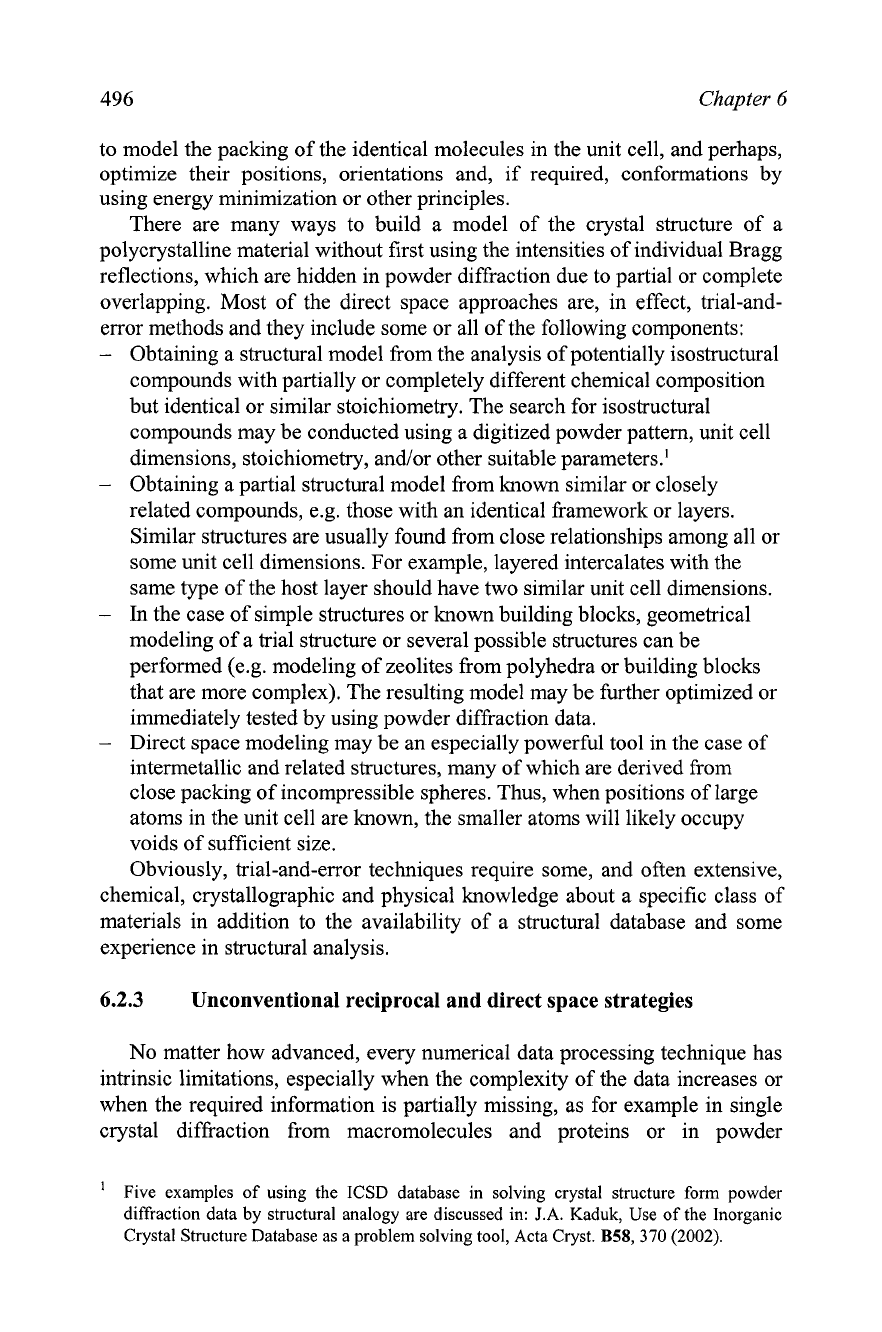
Chapter
6
to model the packing of the identical molecules in the unit cell, and perhaps,
optimize their positions, orientations and, if required, conformations by
using energy minimization or other principles.
There are many ways to build a model of the crystal structure of a
polycrystalline material without first using the intensities of individual Bragg
reflections, which are hidden in powder diffraction due to partial or complete
overlapping. Most of the direct space approaches are, in effect,
trial-and-
error methods and they include some or all of the following components:
-
Obtaining a structural model from the analysis of potentially isostructural
compounds with partially or completely different chemical composition
but identical or similar stoichiometry. The search for isostructural
compounds may be conducted using a digitized powder pattern, unit cell
dimensions, stoichiometry,
and/or other suitable parameters.'
-
Obtaining a partial structural model from known similar or closely
related compounds, e.g. those with an identical framework or layers.
Similar structures are usually found from close relationships among all or
some unit cell dimensions. For example, layered intercalates with the
same type of the host layer should have two similar unit cell dimensions.
-
In
the case of simple structures or known building blocks, geometrical
modeling of a trial structure or several possible structures can be
performed (e.g. modeling of zeolites from polyhedra or building blocks
that are more complex). The resulting model may be further optimized or
immediately tested by using powder diffraction data.
-
Direct space modeling may be an especially powerful tool in the case of
intermetallic and related structures, many of which are derived from
close packing of incompressible spheres. Thus, when positions of large
atoms in the unit cell are known, the smaller atoms will likely occupy
voids of sufficient size.
Obviously, trial-and-error techniques require some, and often extensive,
chemical, crystallographic and physical knowledge about a specific class of
materials in addition to the availability of a structural database and some
experience in structural analysis.
6.2.3
Unconventional reciprocal and direct space strategies
No matter how advanced, every numerical data processing technique has
intrinsic limitations, especially when the complexity of the data increases or
when the required information is partially missing, as for example in single
crystal diffraction from macromolecules and proteins or in powder
Five examples of using the ICSD database in solving crystal structure form powder
diffraction data by structural analogy are discussed in: J.A. Kaduk, Use of the Inorganic
Crystal Structure Database as a problem solving tool, Acta Cryst.
B58,370
(2002).
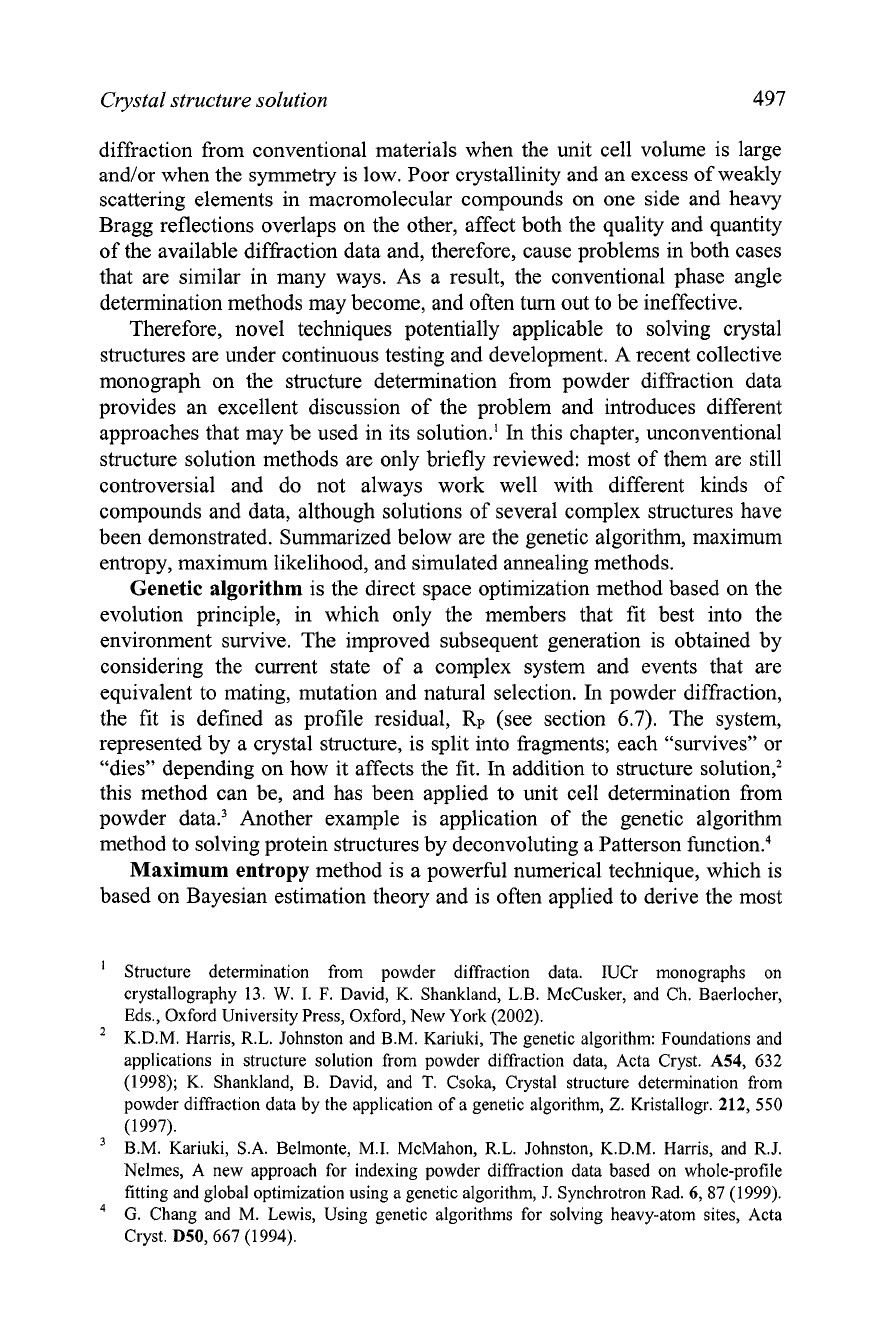
Crystal structure solution 497
diffraction from conventional materials when the unit cell volume is large
and/or when the symmetry is low. Poor crystallinity and an excess of weakly
scattering elements in macromolecular compounds on one side and heavy
Bragg reflections overlaps on the other, affect both the quality and quantity
of the available diffraction data and, therefore, cause problems in both cases
that are similar in many ways. As a result, the conventional phase angle
determination methods may become, and often turn out to be ineffective.
Therefore, novel techniques potentially applicable to solving crystal
structures are under continuous testing and development. A recent collective
monograph on the structure determination from powder diffraction data
provides an excellent discussion of the problem and introduces different
approaches that may be used in its solution.'
In
this chapter, unconventional
structure solution methods are only briefly reviewed: most of them are still
controversial and do not always work well with different kinds of
compounds and data, although solutions of several complex structures have
been demonstrated. Summarized below are the genetic algorithm, maximum
entropy, maximum likelihood, and simulated annealing methods.
Genetic algorithm
is the direct space optimization method based on the
evolution principle, in which only the members that fit best into the
environment survive. The improved subsequent generation is obtained by
considering the current state of a complex system and events that are
equivalent to mating, mutation and natural selection.
In
powder diffraction,
the fit is defined as profile residual,
Rp
(see section
6.7).
The system,
represented by a crystal structure, is split into fragments; each "survives" or
"dies" depending on how it affects the fit.
In
addition to structure solution,2
this method can be, and has been applied to unit cell determination from
powder
dataq3 Another example is application of the genetic algorithm
method to solving protein structures by deconvoluting a Patterson f~nction.~
Maximum entropy
method is a powerful numerical technique, which is
based on Bayesian estimation theory and is often applied to derive the most
Structure determination from powder diffraction data. IUCr monographs on
crystallography 13.
W.
I.
F.
David, K. Shankland, L.B. McCusker, and Ch. Baerlocher,
Eds., Oxford University Press, Oxford, New York (2002).
K.D.M. Harris, R.L. Johnston and B.M. Kariuki, The genetic algorithm: Foundations and
applications in structure solution from powder diffraction data, Acta
Cryst.
A54,
632
(1998); K. Shankland, B. David, and T. Csoka, Crystal structure determination from
powder diffraction data by the application of a genetic algorithm,
Z.
Kristallogr.
212,
550
(1997).
B.M. Kariuki, S.A. Belmonte, M.I. McMahon, R.L. Johnston, K.D.M. Harris, and R.J.
Nelmes, A new approach for indexing powder diffraction data based on whole-profile
fitting and global optimization using a genetic algorithm,
J.
Synchrotron Rad.
6,
87 (1999).
G.
Chang and M. Lewis, Using genetic algorithms for solving heavy-atom sites, Acta
Cryst. D50,667 (1 994).
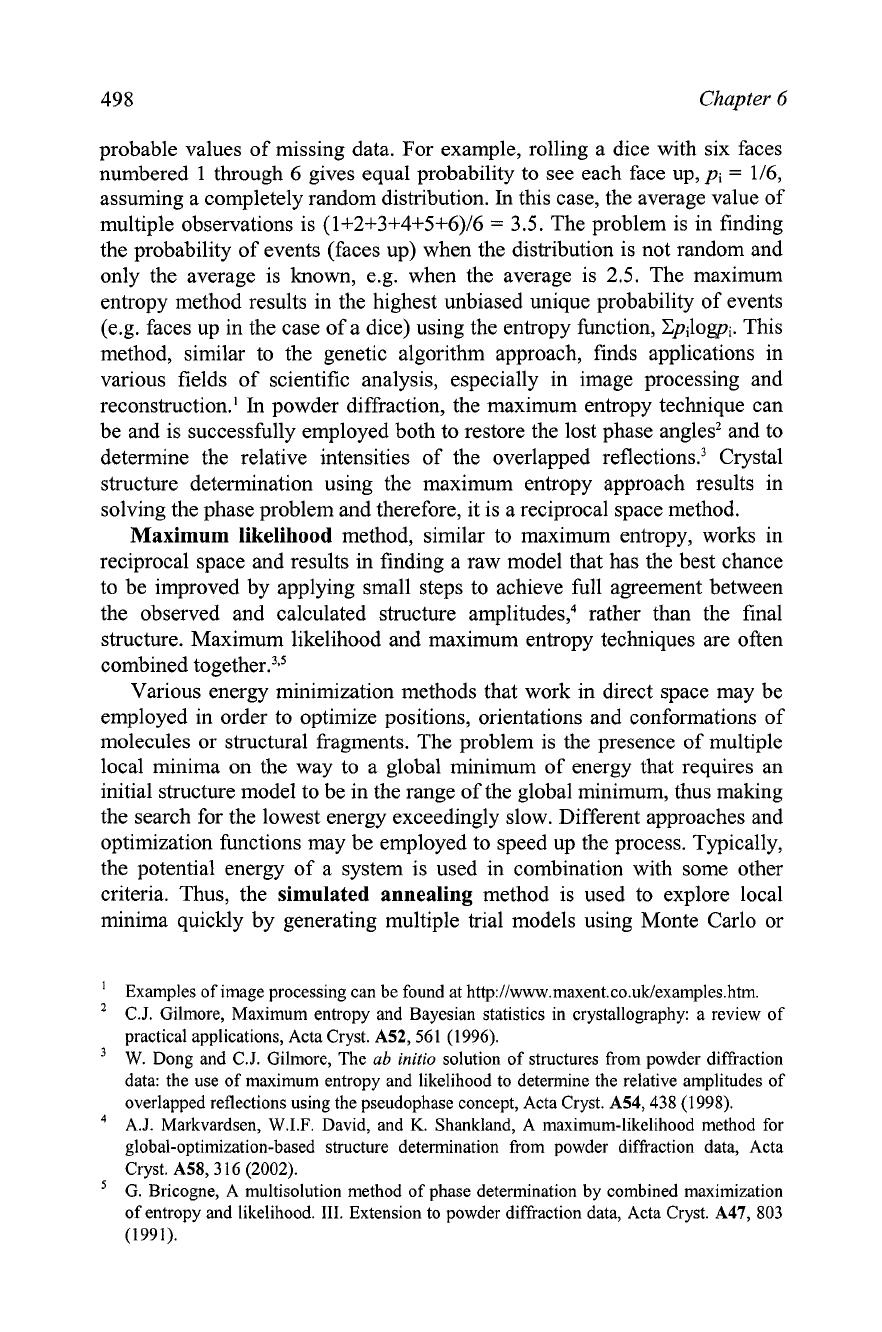
498
Chapter
6
probable values of missing data. For example, rolling a dice with six faces
numbered
1
through 6 gives equal probability to see each face up,
pi
=
116,
assuming a completely random distribution.
In
this case, the average value of
multiple observations is (1+2+3+4+5+6)/6
=
3.5. The problem is in finding
the probability of events (faces up) when the distribution is not random and
only the average is
known,
e.g. when the average is 2.5. The maximum
entropy method results in the highest unbiased unique probability of events
(e.g. faces up in the case of a dice) using the entropy function, Cpiloppi. This
method, similar to the genetic algorithm approach, finds applications in
various fields of scientific analysis, especially in image processing and
reconstruction.'
In
powder diffraction, the maximum entropy technique can
be and is successfully employed both to restore the lost phase angles2 and to
determine the relative intensities of the overlapped
reflection^.^
Crystal
structure determination using the maximum entropy approach results in
solving the phase problem and therefore, it is a reciprocal space method.
Maximum likelihood
method, similar to maximum entropy, works in
reciprocal space and results in finding a raw model that has the best chance
to be improved by applying small steps to achieve full agreement between
the observed and calculated structure amplitudes: rather than the final
structure. Maximum likelihood and maximum entropy techniques are often
combined
Various energy minimization methods that work in direct space may be
employed in order to optimize positions, orientations and conformations of
molecules or structural fragments. The problem is the presence of multiple
local minima on the way to a global minimum of energy that requires an
initial structure model to be in the range of the global minimum, thus making
the search for the lowest energy exceedingly slow. Different approaches and
optimization functions may be employed to speed up the process. Typically,
the potential energy of a system is used in combination with some other
criteria. Thus, the
simulated annealing
method is used to explore local
minima quickly by generating multiple trial models using Monte Carlo or
Examples of image processing can be found at
http://www.maxent.co.uk~examples.htm.
C.J. Gilmore, Maximum entropy and Bayesian statistics in crystallography: a review of
practical applications, Acta Cryst.
A52, 561 (1996).
W. Dong and C.J. Gilmore, The
ab
initio
solution of structures from powder diffraction
data: the use of maximum entropy and likelihood to determine the relative amplitudes of
overlapped reflections using the pseudophase concept, Acta Cryst.
A54,438 (1998).
A.J. Markvardsen, W.I.F. David, and
K.
Shankland, A maximum-likelihood method for
global-optimization-based structure determination from powder diffraction data, Acta
Cryst.
A58,3 16
(2002).
G. Bricogne, A multisolution method of phase determination by combined maximization
of entropy and likelihood.
111. Extension to powder diffraction data, Acta Cryst.
A47, 803
(1 99
1).
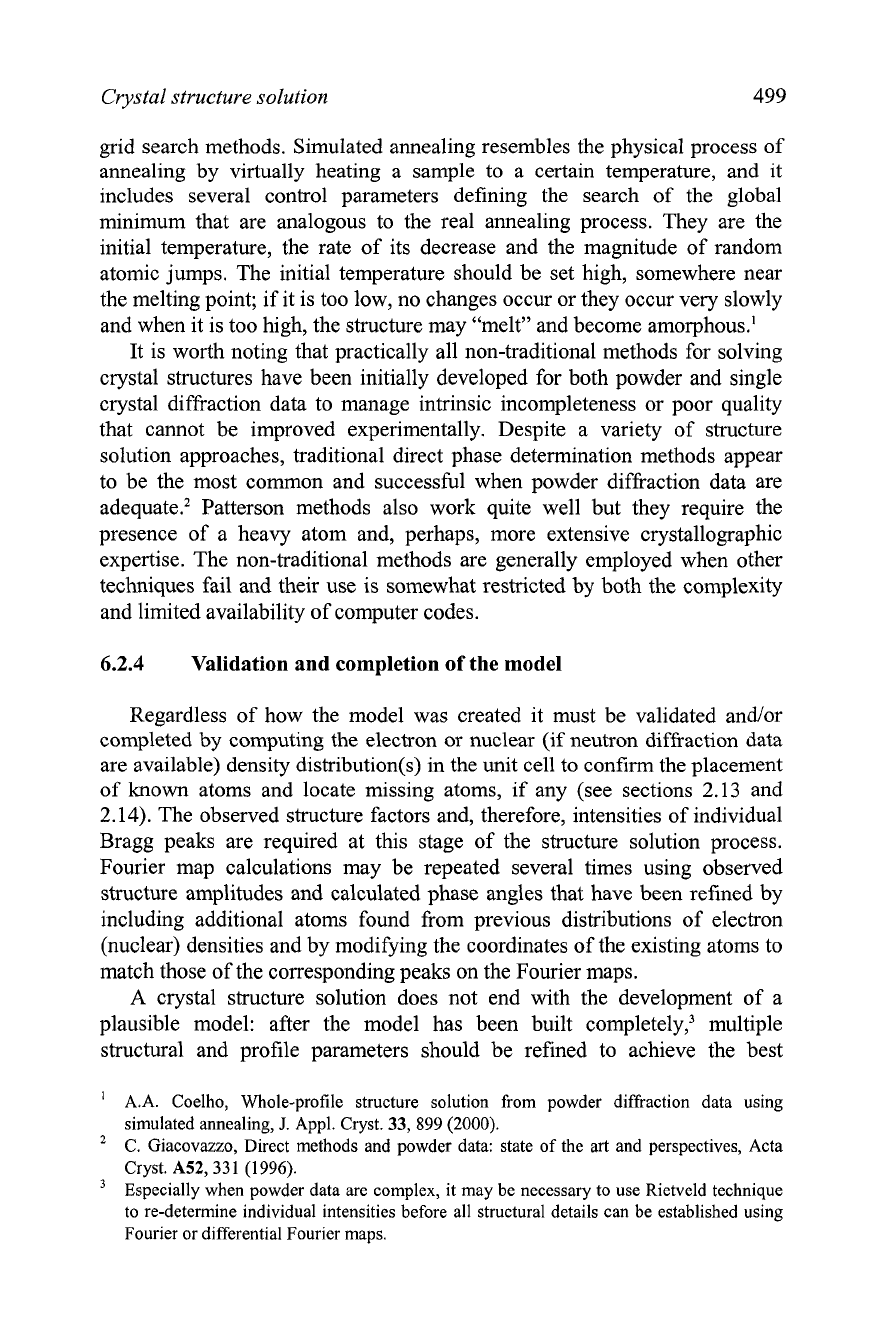
Crystal structure solution
499
grid search methods. Simulated annealing resembles the physical process of
annealing by virtually heating a sample to a certain temperature, and it
includes several control parameters defining the search of the global
minimum that are analogous to the real annealing process. They are the
initial temperature, the rate of its decrease and the magnitude of random
atomic jumps. The initial temperature should be set high, somewhere near
the melting point; if it is too low, no changes occur or they occur very slowly
and when it is too high, the structure may "melt" and become amorphous.'
It is worth noting that practically all non-traditional methods for solving
crystal structures have been initially developed for both powder and single
crystal diffraction data to manage intrinsic incompleteness or poor quality
that cannot be improved experimentally. Despite a variety of structure
solution approaches, traditional direct phase determination methods appear
to be the most common and successful when powder diffraction data are
adeq~ate.~ Patterson methods also work quite well but they require the
presence of a heavy atom and, perhaps, more extensive crystallographic
expertise. The non-traditional methods are generally employed when other
techniques fail and their use is somewhat restricted by both the complexity
and limited availability of computer codes.
6.2.4
Validation and completion of the model
Regardless of how the model was created it must be validated andlor
completed by computing the electron or nuclear (if neutron diffraction data
are available) density
distribution(s) in the unit cell to confirm the placement
of known atoms and locate missing atoms, if any (see sections 2.13 and
2.14). The observed structure factors and, therefore, intensities of individual
Bragg peaks are required at this stage of the structure solution process.
Fourier map calculations may be repeated several times using observed
structure amplitudes and calculated phase angles that have been refined by
including additional atoms found from previous distributions of electron
(nuclear) densities and by modifying the coordinates of the existing atoms to
match those of the corresponding peaks on the Fourier maps.
A
crystal structure solution does not end with the development of a
plausible model: after the model has been built completely,' multiple
structural and profile parameters should be refined to achieve the best
'
A.A.
Coelho, Whole-profile structure solution from powder diffraction data using
simulated annealing,
J.
Appl. Cryst.
33,
899 (2000).
C. Giacovazzo, Direct methods and powder data: state of the art and perspectives, Acta
Cryst.
A52,33
1
(1
996).
Especially when powder data are complex, it may be necessary to use Rietveld technique
to re-determine individual intensities before all structural details can be established using
Fourier or differential Fourier maps.

500
Chapter
6
possible agreement between the observed and calculated powder diffraction
patterns or, in other words, between the crystal structure and the observed
reciprocal space image. At the same time, the crystal structure should make
both chemical (e.g. oxidation states, charge balance, valence, coordination,
etc.) and physical
(e.g. interatomic distances, valence and torsion angles,
coordination polyhedra, etc.) sense. Rietveld refinement employing powder
diffraction data, which will be considered in the next chapter, is an important
step in both the validation and completion of the model.
6.3
The content
of
the unit cell
Consider
Figure
6.2,
which illustrates the crystal structure of elemental
copper. If the lattice parameters are known, so is the volume of its unit cell.
Furthermore, if we know the total number of atoms located in this or any
other unit cell, it is easy to calculate the gravimetric density of a material by
dividing the mass of all atoms located in one unit cell by its volume.
The inverse calculation is also possible: the content of the unit cell may
be determined from the known chemical composition, lattice parameters and
density of a material. Assume that the total mass of all atoms located in one
unit cell is
m.
Also, assume that the unit cell volume is
V.
The latter is
known from diffraction analysis as soon as lattice parameters have been
established (see
Eq.
5.41) Thus, provided the gravimetric density (p) of the
crystalline material has been measured, the mass of one unit cell can be
easily calculated:
Figure
6.2.
One unit cell in the crystal structure of elemental copper illustrating that a point
located in a corner contributes
118
of an atom, and a point located on a face contributes
112
of
an atom to the overall content of the unit cell. Similarly, a point located on an edge would
contribute
114
of an atom. The overall content of this unit cell is
8x118
+
6x
112
=
4
Cu atoms.
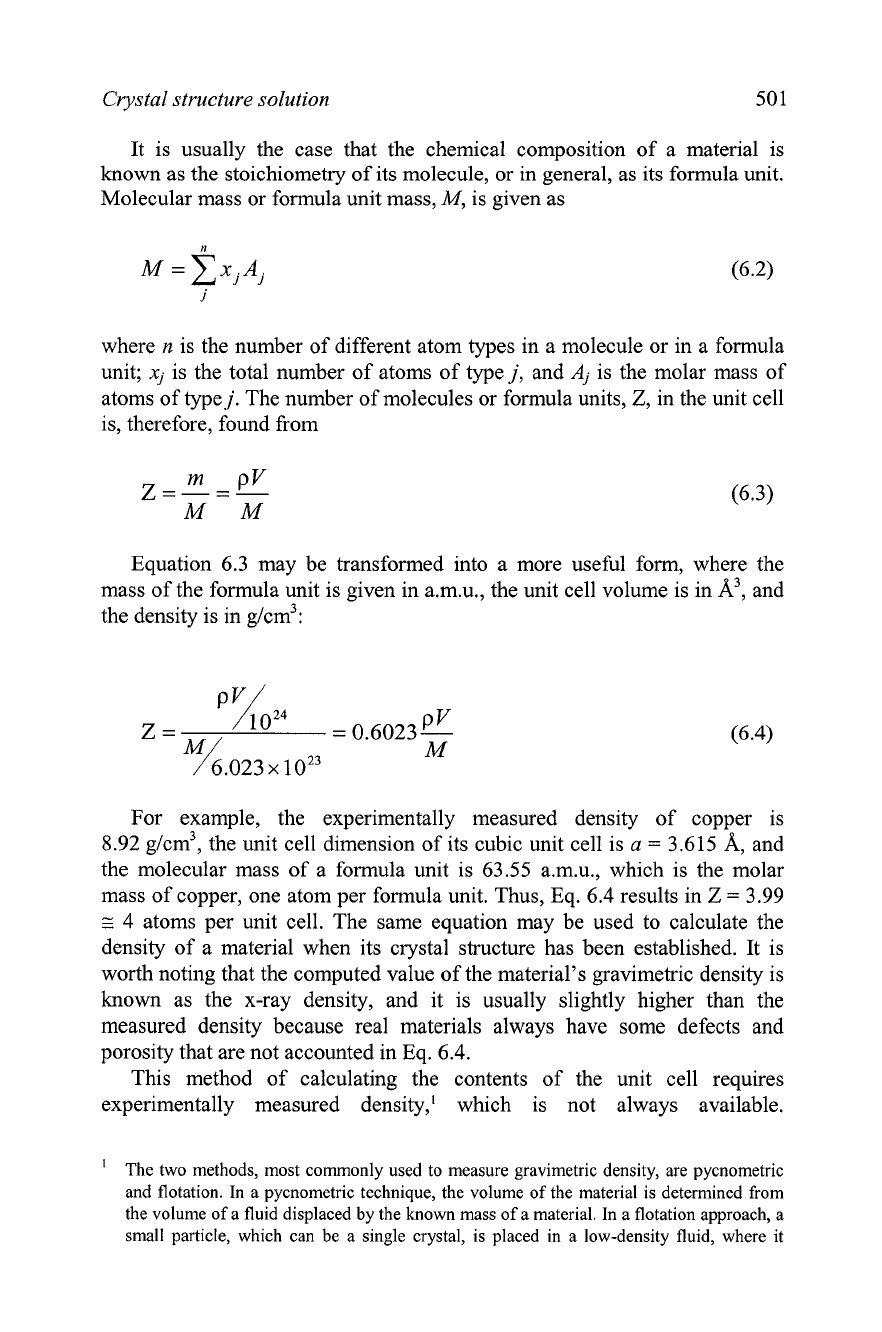
Crystal structure solution
501
It is usually the case that the chemical composition of a material is
known as the stoichiometry of its molecule, or in general, as its formula unit.
Molecular mass or formula unit mass,
M,
is given as
where
n
is the number of different atom types in a molecule or in a formula
unit;
xj
is the total number of atoms of type j, and
Aj
is the molar mass of
atoms of type j. The number of molecules or formula units, Z, in the unit cell
is, therefore, found from
Equation 6.3 may be transformed into a more useful form, where the
mass of the formula unit is given in
a.m.u., the unit cell volume is in A3, and
the density is in
g/cm3:
For example, the experimentally measured density of copper is
8.92
g/cm3, the unit cell dimension of its cubic unit cell is
a
=
3.615 A, and
the molecular mass of a formula unit is 63.55 a.m.u., which is the molar
mass of copper, one atom per formula unit. Thus, Eq. 6.4 results in Z
=
3.99
E
4 atoms per unit cell. The same equation may be used to calculate the
density of a material when its crystal structure has been established. It is
worth noting that the computed value of the material's gravimetric density is
known as the x-ray density, and it is usually slightly higher than the
measured density because real materials always have some defects and
porosity that are not accounted in Eq. 6.4.
This method of calculating the contents of the unit cell requires
experimentally measured density,' which is not always available.
The two methods, most commonly used to measure gravimetric density, are pycnometric
and flotation. In a pycnometric technique, the volume of the material is determined from
the volume of
a
fluid displaced
by
the known mass of a material. In a flotation approach, a
small particle, which can be a single crystal, is placed in a low-density fluid, where it
